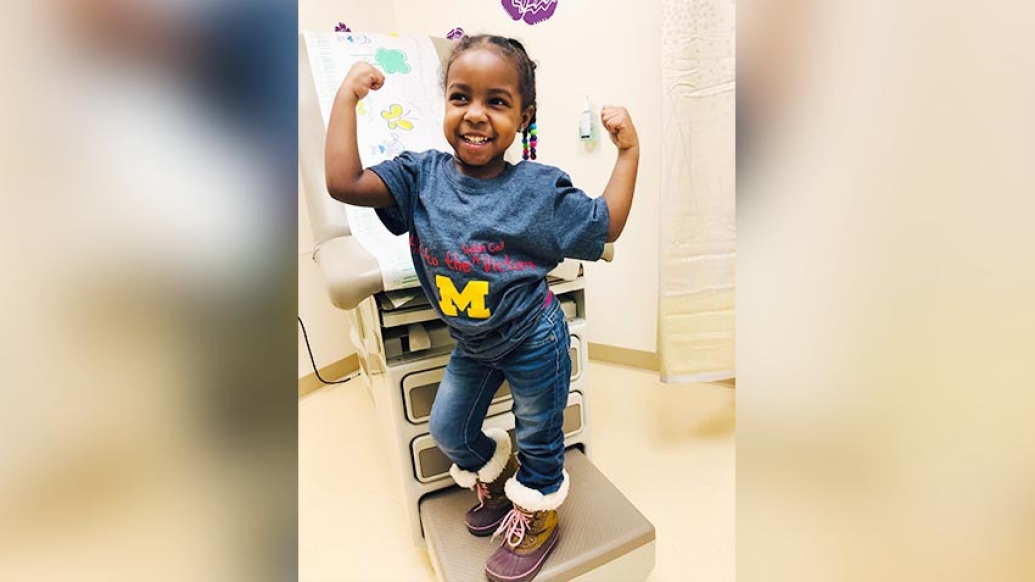After Shavonn Burgess got her daughter’s diagnosis, she had no idea how her family would cope. Now, after a year of blood transfusions and spleen removal, they’ve found a new normal.
1:20 PM
Author |

Shavonn Burgess was ecstatic to welcome her new bundle of joy, Kennedy, to the family after her birth in July, 2016. Unfortunately, a postcard in the mail would throw a wrench in the perfect first week home.
Six days after Kennedy's birth, Burgess' husband placed a pink, certified postcard on the kitchen counter and calmly proclaimed they'd received a letter from the Sickle Cell Disease Association of America. They'd need to pick it up from the post office in two days.
Burgess had never received a letter like this when her oldest daughter was born, so her heart sank when she realized something must be wrong. She didn't know at the time that this would be the beginning of Kennedy's journey with episodes of sickle cell pain, chronic blood transfusions and eventual spleen removal.
Getting a Sickle Cell Disease Diagnosis
"For two nights, my husband had to basically rock me to sleep," she recalled. "When Monday came around, I had to be one of the first five people in the post office line, but it felt like I was number 5,000."
She ran back to her car, letter now in hand. She tore open the envelope and read that her daughter had Sickle Cell Disease SS, an inherited mutation in hemoglobin that turns normal, round and flexible red blood cells into rigid crescent moons, potentially blocking oxygen from traveling throughout the body.
This type in particular means Kennedy had a copy of the sickle cell gene from each of her parents, resulting in more serious illness.
Burgess' face hit the steering and she burst into tears.
"I tried to pray but nothing came out," she says. "I didn't want to call my husband because he was at work and I needed to get myself together a little more before I told him. So, I called my mom and she prayed for me while I couldn't."
Her mother's strength and words of courage got Burgess home.
The family began to educate themselves about sickle cell, as well as connect with other families conquering the disease. Sickle Cell Disease is relatively rare and most common in the African American community, affecting up to 100,000 U.S. children.
Burgess learned that dehydration and cold temperatures can facilitate the sickling of red blood cells, so Kennedy would need to drink plenty of water throughout the day, only swim in heated pools and avoid the use of icepacks. And although rare, she read encouraging testimonies, like how someone's child grew up with the disease and was now successful in school, or how some families' children only have "a few doctors' appointments", but that's it and "they're fine".
But Burgess got her first dose of reality from one parent that told her it isn't just a few doctors' appointments, and it isn't easy.
Kennedy, now 4, started a journey that reflects that struggle after finding Michigan Medicine's C.S. Mott Children's Hospital in February 2017.
Managing Sickle Cell Disease
"It felt like every time we'd go to a doctor's appointment, we were preparing for another one," Burgess says. "We had to see an ophthalmologist, audiologist, radiologist… the pathology department knows us on a first name basis. None of this includes appointments with the primary care physician."
Kennedy's physician, Sharon Singh, M.D., is a pediatric hematologist and oncologist at Mott. She's been in sickle cell disease work for more than a decade and has overseen Kennedy's care for the last three years.
Kennedy was already getting blood transfusions to put normal red blood cells in her body for approximately a year before meeting Singh.
The blood transfusions were necessary because the only known drug for sickle cell disease at the time, Hydroxyurea, wasn't strong enough to keep Kennedy's cells from sickling.
"Hydroxyurea makes the red blood cells bigger, rounder and more flexible because it increases the fetal hemoglobin in the cell," Singh says. "Kennedy's cells would sickle and trap blood in her spleen, causing the spleen to become enlarged. It can cause shock, and even be life-threatening within a few hours."
For some children with sickle cell, the blood cells will break because of how rigid they are. This means there isn't any blockage in the body, or the blockage's associated pain. Although there isn't a blockage, this can cause vascular problems in the long term because of how the blood vessels become so damaged, similar to how high blood pressure damages blood vessels.
For those that have sickled cells that don't break, a blockage can occur in any organ of the body. This is why children with sickle cell disease are evaluated from head to toe.
"This can be especially scary for families whose children may have sickling in the brain," Singh says. "This is when sickle cell disease can make children susceptible to strokes and permanent brain damage."
In Kennedy's case, the disease makes her at high risk for infection because the spleen, a common site of sickle cell complications, is responsible for filtering out bad bacteria.
Her spleen can't perform this task when the sickled cells damage the tissue or obviously, if the spleen is removed completely. However, Kennedy's team made the decision to remove her spleen.

According to Singh, the increase in infection risk was minimal compared to her baseline infection risk from being a patient with sickle cell disease that attacked the spleen.
"The research shows that patients with sickle cell as young as one years old can have signs of organ damage," Singh says. "So the team decided that we should remove the spleen and see if we can gradually decrease the number of transfusions Kennedy needs."
Today, Kennedy is learning from home to keep healthy during the COVID-19 pandemic. Because of her condition, she has been "staying in place" since her port removal procedure in early March.
Maintaining her social, emotional and physical health has required creativity that includes "sleep overs" in her sister's room, backyard movie nights, bike rides and making s'mores.
Although the last few months have brought unique challenges, Burgess is thankful to be able to manage Kennedy's sickle cell pain from home.
The Future of Sickle Cell Care
Little Victors living with sickle cell disease, like Kennedy, can coordinate school care through Mott to assure accommodations are made to ensure children with the disease are set up for success. Things like setting time aside for rest, taking more water breaks and being the first to get picked up by the bus in the morning to avoid waiting outside in cold temperatures too long, can all be handled.
Although these accommodations exist, no child would need them in an ideal world where sickle cell disease didn't exist.
"There's more hope now for families affected by this disease," Singh says. "There was only one medication to manage sickle cell disease up until a few years ago. Now there's several more, and we keep getting closer to curative treatments."
One option patients have is a bone marrow transplant, but there are risks associated with the introduction of someone else's bone marrow in the body. The latest in sickle cell research is looking to gene therapy, which involves having a patient's own stem cells removed, altered to correct the sickling and then placed back in the patient.
Although sickle cell research has come a long way, Singh is still concerned that the funding and attention to the condition lags behind other conditions. There are still gaps in the knowledge of sickle cell disease mechanisms, and an important resource in filling in these gaps are more research dollars.
"Many people only see the tip of the iceberg with this disease, maybe a fever and some degree of pain every once and a while," Singh says. "What they don't see is all the suffering at home. Missed days at work and school, the pain that's there every day but isn't severe enough to warrant an ER visit, the stress on the siblings when they don't get to see a family member who might always be at the hospital because of another appointment."
"Each day we try to take on courage and faith and more days than not, we beat out the anxiety and fear," Burgess says. "We're still concerned but we choose daily not to focus on the anxiety and fear."
Burgess and her husband co-founded Kennedy's Village Inc., a non-profit organization focused on family empowerment and raising funds for research to "reshape sickle cell disease". Learn more about Kennedy's story and sickle cell disease.

Explore a variety of health care news & stories by visiting the Health Lab home page for more articles.

Department of Communication at Michigan Medicine
Want top health & research news weekly? Sign up for Health Lab’s newsletters today!





